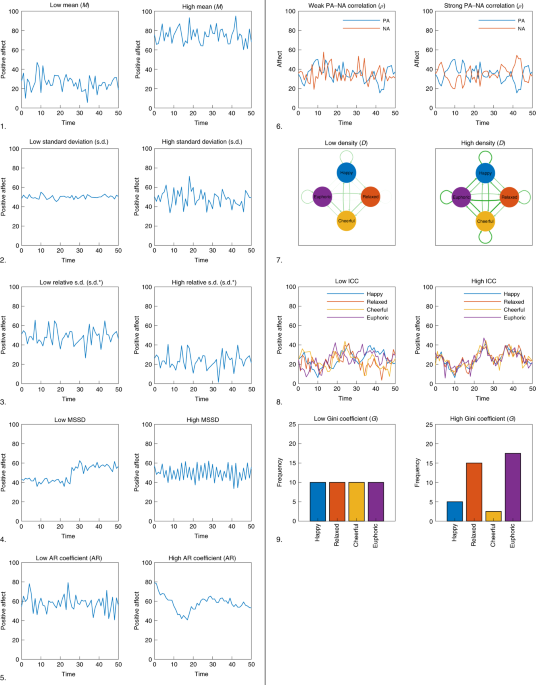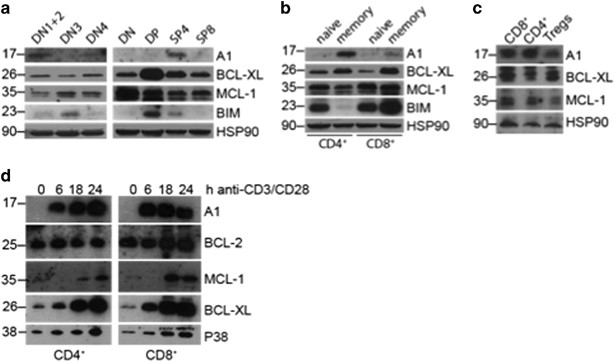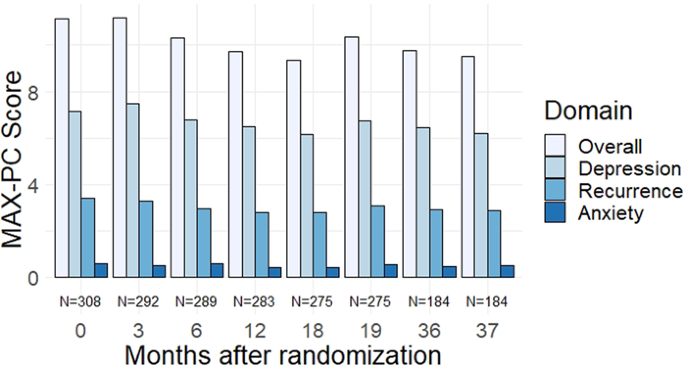
- Select a language for the TTS:
- UK English Female
- UK English Male
- US English Female
- US English Male
- Australian Female
- Australian Male
- Language selected: (auto detect) - EN
Play all audios:
ABSTRACT Over the years, many studies have demonstrated a relation between emotion dynamics and psychological well-being1. Because our emotional life is inherently time-dynamic2,3,4,5,6,
affective scientists argue that, next to how positive or negative we feel on average, patterns of emotional change are informative for mental health7,8,9,10. This growing interest initiated
a surge in new affect dynamic measures, each claiming to capture a unique dynamical aspect of our emotional life, crucial for understanding well-being. Although this accumulation suggests
scientific progress, researchers have not always evaluated (a) how different affect dynamic measures empirically interrelate and (b) what their added value is in the prediction of
psychological well-being. Here, we address these questions by analysing affective time series data from 15 studies (_n_ = 1,777). We show that (a) considerable interdependencies between
measures exist, suggesting that single dynamics often do not convey unique information, and (b) dynamic measures have little added value over mean levels of positive and negative affect (and
variance in these affective states) when predicting individual differences in three indicators of well-being (life satisfaction, depressive symptoms and borderline symptoms). Our findings
indicate that conventional emotion research is currently unable to demonstrate independent relations between affect dynamics and psychological well-being. Access through your institution Buy
or subscribe This is a preview of subscription content, access via your institution ACCESS OPTIONS Access through your institution Access Nature and 54 other Nature Portfolio journals Get
Nature+, our best-value online-access subscription $29.99 / 30 days cancel any time Learn more Subscribe to this journal Receive 12 digital issues and online access to articles $119.00 per
year only $9.92 per issue Learn more Buy this article * Purchase on SpringerLink * Instant access to full article PDF Buy now Prices may be subject to local taxes which are calculated during
checkout ADDITIONAL ACCESS OPTIONS: * Log in * Learn about institutional subscriptions * Read our FAQs * Contact customer support SIMILAR CONTENT BEING VIEWED BY OTHERS SLOW DOWN AND BE
CRITICAL BEFORE USING EARLY WARNING SIGNALS IN PSYCHOPATHOLOGY Article 10 October 2024 POSITIVE AFFECT AND HEART RATE VARIABILITY: A DYNAMIC ANALYSIS Article Open access 25 March 2024 THE
EFFECT OF ATTENTIONAL BIAS MODIFICATION ON POSITIVE AFFECT DYNAMICS Article Open access 09 October 2024 DATA AVAILABILITY To run the code and reproduce our analyses, two datasets17,29 are
provided in the Supplementary Data or are available online from the Open Science Framework (http://osf.io/zm6uw). The other datasets used in this article are available upon reasonable
request from the original sources referenced in Supplementary Table 1, but restrictions apply to the availability of these data, which were used under licence for the current study, and so
are not publicly available. CODE AVAILABILITY All analyses reported in this paper were conducted in MATLAB (R2017a), except the visualization of the correlational network, which was
performed in R (v.3.4.0). The reproducible MATLAB and R code are provided as Supplementary Matlab Code and Supplementary R Code, respectively, or are available online from the Open Science
Framework (http://osf.io/zm6uw). REFERENCES * Houben, M., Van Den Noortgate, W. & Kuppens, P. The relation between short-term emotion dynamics and psychological well-being: a
meta-analysis. _Psychol. Bull._ 141, 901–930 (2015). PubMed Google Scholar * Davidson, R. J., Jackson, D. C. & Kalin, N. H. Emotion, plasticity, context, and regulation: perspectives
from affective neuroscience. _Psychol. Bull._ 126, 890–909 (2000). PubMed Google Scholar * Frijda, N. H. _The Laws of Emotion_ (Erlbaum, Hillsdale, 2007). * Kuppens, P. It’s about time: a
special section on affect dynamics. _Emot. Rev._ 7, 297–300 (2015). Google Scholar * Larsen, R. J. Towards a science of mood regulation. _Psychol. Inq._ 11, 129–141 (2000). Google Scholar
* Scherer, K. R. The dynamic architecture of emotion: evidence for the component process model. _Cogn. Emot._ 23, 1307–1351 (2009). Google Scholar * Koval, P., Sütterlin, S. & Kuppens,
P. Emotional inertia is associated with lower well-being when controlling for differences in emotional context. _Front. Psychol._ 6, 1–11 (2015). Google Scholar * Kuppens, P., Allen, N. B.
& Sheeber, L. B. Emotional inertia and psychological maladjustment. _Psychol. Sci._ 21, 984–991 (2010). PubMed PubMed Central Google Scholar * Kuppens, P. et al. Emotional inertia
prospectively predicts the onset of depressive disorder in adolescence. _Emotion_ 12, 283–289 (2012). PubMed Google Scholar * van de Leemput, I. A. et al. Critical slowing down as early
warning for the onset and termination of depression. _Proc. Natl Acad. Sci. USA_ 111, 87–92 (2014). PubMed Google Scholar * Kuppens, P., Oravecz, Z. & Tuerlinckx, F. Feelings change:
accounting for individual differences in the temporal dynamics of affect. _J. Pers. Soc. Psychol._ 99, 1042–1060 (2010). PubMed Google Scholar * Russell, J. A. Core affect and the
psychological construction of emotion. _Psychol. Rev._ 110, 145–172 (2003). PubMed Google Scholar * Scherer, K. R. in _Introduction to Social Psychology: A European Perspective_ 3rd edn
(eds Hewstone, M. & Stroebe, W.) 151–191 (Blackwell, Oxford, 2000). * Dejonckheere, E. et al. The bipolarity of affect and depressive symptoms. _J. Pers. Soc. Psychol._ 114, 323–341
(2018). PubMed Google Scholar * Grühn, D., Lumley, M. A., Diehl, M. & Labouvie-vief, G. Time-based indicators of emotional complexity: interrelations and correlates. _Emotion_ 13,
226–237 (2013). PubMed Google Scholar * Jahng, S., Wood, P. K. & Trull, T. J. Analysis of affective instability in ecological momentary assessment: indices using successive difference
and group comparison via multilevel modeling. _Psychol. Methods_ 13, 354–375 (2008). PubMed Google Scholar * Koval, P., Pe, M. L., Meers, K. & Kuppens, P. Affect dynamics in relation
to depressive symptoms: variable, unstable or inert? _Emotion_ 13, 1132–1141 (2013). PubMed Google Scholar * Van der Gucht, K. et al. An experience sampling study examining the potential
impact of a mindfulness-based intervention on emotion differentiation. _Emotion_ 19, 123–131 (2018). PubMed Google Scholar * Thompson, R. J. et al. The everyday emotional experience of
adults with major depressive disorder: examining emotional instability, inertia, and reactivity. _J. Abnorm. Psychol._ 121, 819–829 (2012). PubMed PubMed Central Google Scholar *
Mestdagh, M. et al. The relative variability index as a generic mean-corrected variability measure for bounded variables. _Psychol. Methods_ 23, 690–707 (2019). Google Scholar * Brown, N.
J. L. & Coyne, J. C. Emodiversity: robust predictor of outcomes or statistical artifact?. _J. Exp. Psychol. Gen._ 146, 1372–1377 (2017). PubMed Google Scholar * Clark, L. A. &
Watson, D. Tripartite model of anxiety and depression: psychometric evidence and taxonomic implications. _J. Abnorm. Psychol._ 100, 316–336 (1991). CAS PubMed Google Scholar * Larson, R.
M., Csikszentmihalyi, M. & Graef, R. Mood variability and the psychosocial adjustment of adolescents. _J. Youth Adolesc._ 9, 469–490 (1980). CAS PubMed Google Scholar * von Mises, R.
_Mathematical Theory and Probability and Statistics_ (Academic Press, New York, 1964). * Diener, E., Sandvik, E., & Pavot, W. in _Subjective Well-being: An Interdisciplinary Perspective_
(eds Strack, F., Argyle, M. & Schwarz, N.) 119–139 (Pergamon, New York, 1991). * Dejonckheere, E., Bastian, B., Fried, E. I., Murphy, S. & Kuppens, P. Perceiving social pressure not
to feel negative predicts depressive symptoms in daily life. _Depress. Anxiety_ 34, 836–844 (2017). PubMed Google Scholar * Heininga, V. E., et al. The dynamical signature of anhedonia in
major depressive disorder: positive emotion dynamics, reactivity, and recovery. _BMC Psychiatry_ 19, 59 (2019). * Houben, M. et al. Emotional switching in borderline personality disorder: a
daily life study. _J. Pers. Disord._ 7, 50–60 (2016). Google Scholar * Dejonckheere, E., Kalokerinos, E. K., Bastian, B., & Kuppens, P. Poor emotion regulation ability mediates the
link between depressive symptoms and affective bipolarity. _Cogn. Emot._ https://doi.org/10.1080/02699931.2018.1524747 (2018). * Pe, M. L., Brose, A., Gotlib, I. H. & Kuppens, P.
Affective updating ability and stressful events interact to prospectively predict increases in depressive symptoms over time. _Emotion_ 16, 73–82 (2016). PubMed Google Scholar * Schmiedek,
F., Lövdén, M. & Lindenberger, U. Hundred days of cognitive training enhance broad cognitive abilities in adulthood: findings from the COGITO study. _Front. Aging Neurosci._ 2, 1–27
(2010). Google Scholar * Sels, L., Ceulemans, E. & Kuppens, P. Partner-expected affect: how you feel now is predicted by how your partner thought you felt before. _Emotion_ 17,
1066–1077 (2017). PubMed Google Scholar * Sels, L., Ceulemans, E., & Kuppens, P. All’s well that ends well? A test of the peak-end rule in couples’ conflict discussions. _Eur. J. Soc.
Psychol._ https://doi.org/10.1002/ejsp.2547 (2018). * Trull, T. J. et al. Affective instability: measuring a core feature of borderline personality disorder with ecological momentary
assessment. _J. Abnorm. Psychol._ 117, 647–661 (2008). PubMed Google Scholar * Csikszentmihalyi, M. & Larson, R. Validity and reliability of the experience-sampling method. _J. Nerv.
Ment. Dis._ 175, 526–536 (1987). CAS PubMed Google Scholar * Bolger, N., Davis, A. & Rafaeli, E. Diary methods: capturing life as it is lived. _Annu. Rev. Psychol._ 54, 579–616
(2003). PubMed Google Scholar * Diener, E., Suh, E. M., Lucas, R. E. & Smith, H. L. Subjective well-being: three decades of progress. _Psychol. Bull._ 125, 276–302 (1999). Google
Scholar * Waterman, A. S. Two conceptions of happiness: contrasts of personal expressiveness (eudaimonia) and hedonic enjoyment. _J. Pers. Soc. Psychol._ 64, 678–691 (1993). Google Scholar
* Vuillier, L. et al. Amount and diversity of digital emotional expression predicts happiness. _Harvard Business School_ 18, 2–42 (2018). Google Scholar * Davis, M. C., Zautra, A. J.
& Smith, B. Chronic pain, stress, and the dynamics of affective differentiation. _J. Pers._ 72, 1133–1159 (2004). PubMed PubMed Central Google Scholar * Santangelo, P. et al.
Specificity of affective instability in patients with borderline personality disorder compared to posttraumatic stress disorder, bulimia nervosa, and healthy controls. _J. Abnorm. Psychol._
123, 258–272 (2014). PubMed PubMed Central Google Scholar * Coifman, K. G., Berenson, K. R., Rafaeli, E. & Downey, G. From negative to positive and back again: polarized affective and
relational experience in borderline personality disorder. _J. Abnorm. Psychol._ 121, 668–679 (2012). PubMed Google Scholar * Demiralp, E. et al. Feeling blue or turquoise? Emotional
differentiation in major depressive disorder. _Psychol. Sci._ 23, 1410–1416 (2012). PubMed PubMed Central Google Scholar * Wolff, S., Stiglmayr, C., Bretz, H. J., Lammers, C. H. &
Auckenthaler, A. Emotion identification and tension in female patients with borderline personality disorder. _Br. J. Psychol._ 46, 347–360 (2007). Google Scholar * Pe, M. L. et al.
Emotion-network density in major depressive disorder. _Clin. Psychol. Sci._ 3, 292–300 (2015). Google Scholar * Quoidbach, J. et al. Emodiversity and the emotional ecosystem. _J. Exp.
Psychol .Gen._ 143, 2057–2066 (2014). PubMed Google Scholar * Erbas, Y., Ceulemans, E., Koval, P. & Kuppens, P. The role of valence focus and appraisal overlap in emotion
differentiation. _Emotion_ 15, 373–382 (2015). PubMed Google Scholar * Meinshausen, N. & Bühlmann, P. Stability selection. _J. R. Stat. Soc._ 72, 417–473 (2010). Google Scholar *
Tibshirani, R. Regression shrinkage and selection via the Lasso. _J. R. Stat. Soc._ 58, 267–288 (1996). Google Scholar * Geisser, S. The predictive sample reuse method with applications.
_J. Am. Stat. Assoc._ 70, 320–328 (1975). Google Scholar * Ebner-Priemer, U. W. & Sawitzki, G. Ambulatory assessment of affective instability in borderline personality disorder: the
effect of the sampling frequency. _Eur. J. Psychol. Assess._ 23, 238–247 (2007). Google Scholar * Moors, A. On the causal role of appraisal in emotion. _Emot. Rev._ 5, 132–140 (2013).
Google Scholar * Frijda, N. H., Kuipers, P., & ter Schure, E. Relations among emotion, appraisal, and emotional action readiness. _J. Pers. Soc. Psychol._ 57, 212–228 (1989). * Fried,
E. I. Problematic assumptions have slowed down depression research: why symptoms, not syndromes are the way forward. _Front. Psychol._ 6, 1–11 (2015). Google Scholar * Fried, E. I. &
Nesse, R. M. Depression sum-scores don’t add up: why analyzing specific depression symptoms is essential. _BMC Med._ 13, 1–11 (2015). Google Scholar * Shmueli, G. To explain or to predict?.
_Stat. Sci._ 25, 289–310 (2010). Google Scholar * Linehan, M. _Cognitive Behavioral Treatment of Borderline Personality Disorder_ (Guilford Press, New York, 1993). * Ebner-Priemer, U. W.
et al. Unraveling affective dysregulation in borderline personality disorder: a theoretical model and empirical evidence. _J. Abnorm. Psychol._ 124, 186–198 (2015). PubMed Google Scholar *
Bulteel, K., Mestdagh, M., Tuerlinckx, F., & Ceulemans, E. VAR(1) based models do not always outpredict AR(1) models in typical psychological applications. _Psychol. Methods_
https://doi.org/10.1037/met0000178 (2018). * Chow, P. I. et al. Using mobile sensing to test clinical models of depression, social anxiety, state affect, and social isolation among college
students, _J. Med. Internet Res._ 19, e62 (2017). * Carreiro, S. et al. Real-time mobile detection of drug use with wearable biosensors: a pilot study. _J. Med. Toxicol._ 11, 73–77 (2014).
PubMed Central Google Scholar * Trull, T. J. & Ebner-Priemer, U. W. Using experience sampling methods/ecological momentary assessment (ESM/EMA) in clinical assessment and clinical
research: introduction to the special section. _Psychol. Assess._ 21, 457–462 (2014). Google Scholar * Erbas, Y. et al. Why I don’t always know what I’m feeling: the role of stress in
within-person fluctuations in emotion differentiation. _J. Pers. Soc. Psychol._ 115, 179–191 (2018). PubMed Google Scholar * Bringmann, L. F. et al. A network approach to psychopathology:
new insights into clinical longitudinal data. _PloS One_ 8, e60188 (2013). CAS PubMed PubMed Central Google Scholar * Ong, A. D., Zautra, A. J. & Finan, P. H. Inter- and
intra-individual variation in emotional complexity: methodological considerations and theoretical implications. _Curr. Opin. Behav. Sci._ 15, 22–26 (2017). PubMed PubMed Central Google
Scholar * Erbas, Y., Ceulemans, E., Pe, M. L., Koval, P. & Kuppens, P. Negative emotion differentiation: its personality and well-being correlates and a comparison of different
assessment methods. _Cogn. Emot._ 28, 1196–1213 (2014). PubMed Google Scholar * Diener, E., Emmons, R. A., Larsen, R. J. & Griffin, S. The satisfaction with life scale. _J. Pers.
Assess._ 49, 71–75 (1985). CAS PubMed Google Scholar * Radloff, L. S. The CES-D scale: a self-report depression scale for research in the general population. _Appl. Psychol. Meas._ 1,
384–401 (1977). Google Scholar * Kroenke, K., Spitzer, R. L. & Williams, J. B. The PHQ-9: validity of a brief depression severity measure. _J. Gen. Intern. Med._ 16, 606–613 (2001). CAS
PubMed PubMed Central Google Scholar * Rush, A. J. et al. An evaluation of the quick inventory of depressive symptomatology and the hamilton rating scale for depression: a sequenced
treatment alternatives to relieve depression trial report. _Biol. Psychiatry_ 59, 493–501 (2006). PubMed Google Scholar * Beck, A. T., Steer, R. A. & Brown, G. K. _Manual for the Beck
Depression Inventory–II_ (Psychological Corporation, San Antonio, 1996). * First, M. B, Spitzer, R. L, Gibbon, M. & Williams, J. B. W. in _Structured Clinical Interview for DSM-IV-TR
Axis I Disorders_ Research Version, Patient Edition. (BiometricsResearch: New York, 2002). * Schotte, C. K. W., de Doncker, D., Vankerckhoven, C., Vertommen, H. & Cosyns, P. Self-report
assessment of the DSM–IV personality disorders. Measurement of trait and distress characteristics: the ADP-IV. _Psychol. Med._ 28, 1179–1188 (1998). CAS PubMed Google Scholar * Distel, M.
A., de Moor, H. M. & Boomsma, D. I. Dutch translation of the personality assessment inventory borderline features scale (PAI-BOR): norms, factor structure and reliability. _Psychol.
Health_ 37, 38–46 (2009). Google Scholar * Morey, L. C. _The personality Assessment Inventory: Professional Manual_ (Psychological Assessment Resources, Odessa, 1991). * First, M. B.,
Gibbon, M., Spitzer, R. L., Williams, J. B. W. & Benjamin, L. S. _Structured Clinical Interview for DSM-IV Axis II Personality Disorders (SCID-II)_ (American Psychiatric Press,
Washington, 1997). * Kutner, M., Nachtsheim, C., Neter, J. & Li, W. _Applied Linear Statistical Models_ 5th edn (McGraw-Hill, New York, 2004). * Nakagawa, S. & Schielzeth, H. A
general and simple method for obtaining _R_² from generalized linear mixed‐effects models. _Methods Ecol. Evol._ 4, 133–142 (2013). Google Scholar * Johnson, P. C. D. Extension of Nakagawa
& Schielzeth’s _R_²GLMM to random slopes models. _Methods Ecol. Evol._ 5, 944–946 (2013). Google Scholar * Watson, D., Clark, L. A. & Tellegen, A. Development and validation of
brief measures of positive and negative affect: the PANAS scales. _J. Pers. Soc. Psychol._ 54, 1063–1070 (1988). CAS PubMed Google Scholar * Eid, M. & Diener, E. Intraindividual
variability in affect: reliability, validity, and personality correlates. _J. Pers. Soc. Psychol._ 76, 662–676 (1999). Google Scholar * Baird, B. M., Le, K. & Lucas, R. E. On the nature
of intraindividual personality variability: reliability, validity, and associations with well-being. _J. Pers. Soc. Psychol._ 90, 512–527 (2006). PubMed Google Scholar * Kalmijn, W. &
Veenhoven, R. Measuring inequality of happiness in nations: in search for proper statistics. _J. Happiness Stud._ 6, 357–396 (2005). Google Scholar * Cowdry, R. W., Gardner, D. L.,
O’Leary, K. M., Leibenluft, E. & Rubinow, D. R. Mood variability: a study of four groups. _Am. J. Psychiatry_ 148, 1505–1511 (1991). CAS PubMed Google Scholar * Barrett, L. F., Gross,
J., Christensen, T. C. & Benvenuto, M. Knowing what you’re feeling and knowing what to do about it: mapping the relation between emotion differentiation and emotion regulation. _Cogn.
Emot._ 15, 713–724 (2001). Google Scholar * Kashdan, T. B., Barrett, L. F. & McKnight, P. E. Unpacking emotion differentiation: transforming unpleasant experience by perceiving
distinctions in negativity. _Curr. Dir. Psychol. Sci._ 24, 10–16 (2015). Google Scholar * Feldman, L. A. Valence focus and arousal focus: individual differences in the structure of
affective experience. _J. Pers. Soc. Psychol._ 69, 153–166 (1995). Google Scholar * Benson, L., Ram, N., Almeida, D., Zautra, A. & Ong, A. D. Fusing biodiversity metrics into
investigations of daily life: illustrations and recommendations with emodiversity. _J. Gerontol. B_ 15, 75–86 (2017). Google Scholar Download references ACKNOWLEDGEMENTS This research was
supported by the Research Fund of KU Leuven (grant nos. GOA/15/003 and OT/11/031). M.M. and M.H. are supported by the Fund of Scientific Research Flanders. We sincerely thank the following
researchers that provided data for this project: A. Brose, B. Bastian, I. Gotlib, J. Jonides, E. Kalokerinos, P. Koval, U. Lindenberger, M. Lövdén, M. Pe, F. Schmiedek, R. Thompson, T. Trull
and K. Van der Gucht. This article uses data from the COGITO study, supported by a grant from the Innovation Fund of the President of the Max Planck Society to U. Lindenberger. The
computational resources and services used in this work were provided by the VSC (Flemish Supercomputer Center), funded by the Research Foundation—Flanders (FWO) and the Flemish Government,
department EWI. The funders had no role in study design, data collection and analysis, decision to publish or preparation of the manuscript. AUTHOR INFORMATION Author notes * These authors
contributed equally: Egon Dejonckheere, Merijn Mestdagh. AUTHORS AND AFFILIATIONS * KU Leuven—Faculty of Psychology and Educational Sciences, Leuven, Belgium Egon Dejonckheere, Merijn
Mestdagh, Marlies Houben, Isa Rutten, Laura Sels, Peter Kuppens & Francis Tuerlinckx Authors * Egon Dejonckheere View author publications You can also search for this author inPubMed
Google Scholar * Merijn Mestdagh View author publications You can also search for this author inPubMed Google Scholar * Marlies Houben View author publications You can also search for this
author inPubMed Google Scholar * Isa Rutten View author publications You can also search for this author inPubMed Google Scholar * Laura Sels View author publications You can also search for
this author inPubMed Google Scholar * Peter Kuppens View author publications You can also search for this author inPubMed Google Scholar * Francis Tuerlinckx View author publications You
can also search for this author inPubMed Google Scholar CONTRIBUTIONS M.M. performed the analyses and E.D. drafted the manuscript. Both authors conceptualized the study project and
interpreted the results under P.K. and F.T.’s supervision. I.R. independently re-analysed parts of the data with different statistical software to achieve converging results. M.H. and L.S.
critically revised the manuscript. All authors approved the final version of the article. CORRESPONDING AUTHORS Correspondence to Egon Dejonckheere or Merijn Mestdagh. ETHICS DECLARATIONS
COMPETING INTERESTS The authors declare no competing interests. ADDITIONAL INFORMATION PUBLISHER’S NOTE: Springer Nature remains neutral with regard to jurisdictional claims in published
maps and institutional affiliations. SUPPLEMENTARY INFORMATION SUPPLEMENTARY INFORMATION Supplementary Figures 1–19, Supplementary Tables 1–16, Supplementary Note, and Supplementary
References. REPORTING SUMMARY SUPPLEMENTARY R CODE R code to reproduce analyses. SUPPLEMENTARY MATLAB CODE Matlab code to reproduce analyses. SUPPLEMENTARY DATA Part of the data underlying
the analyses in the Article. SI GUIDE Description: SI guide explaining file identity. RIGHTS AND PERMISSIONS Reprints and permissions ABOUT THIS ARTICLE CITE THIS ARTICLE Dejonckheere, E.,
Mestdagh, M., Houben, M. _et al._ Complex affect dynamics add limited information to the prediction of psychological well-being. _Nat Hum Behav_ 3, 478–491 (2019).
https://doi.org/10.1038/s41562-019-0555-0 Download citation * Received: 28 June 2018 * Accepted: 06 February 2019 * Published: 15 April 2019 * Issue Date: May 2019 * DOI:
https://doi.org/10.1038/s41562-019-0555-0 SHARE THIS ARTICLE Anyone you share the following link with will be able to read this content: Get shareable link Sorry, a shareable link is not
currently available for this article. Copy to clipboard Provided by the Springer Nature SharedIt content-sharing initiative






